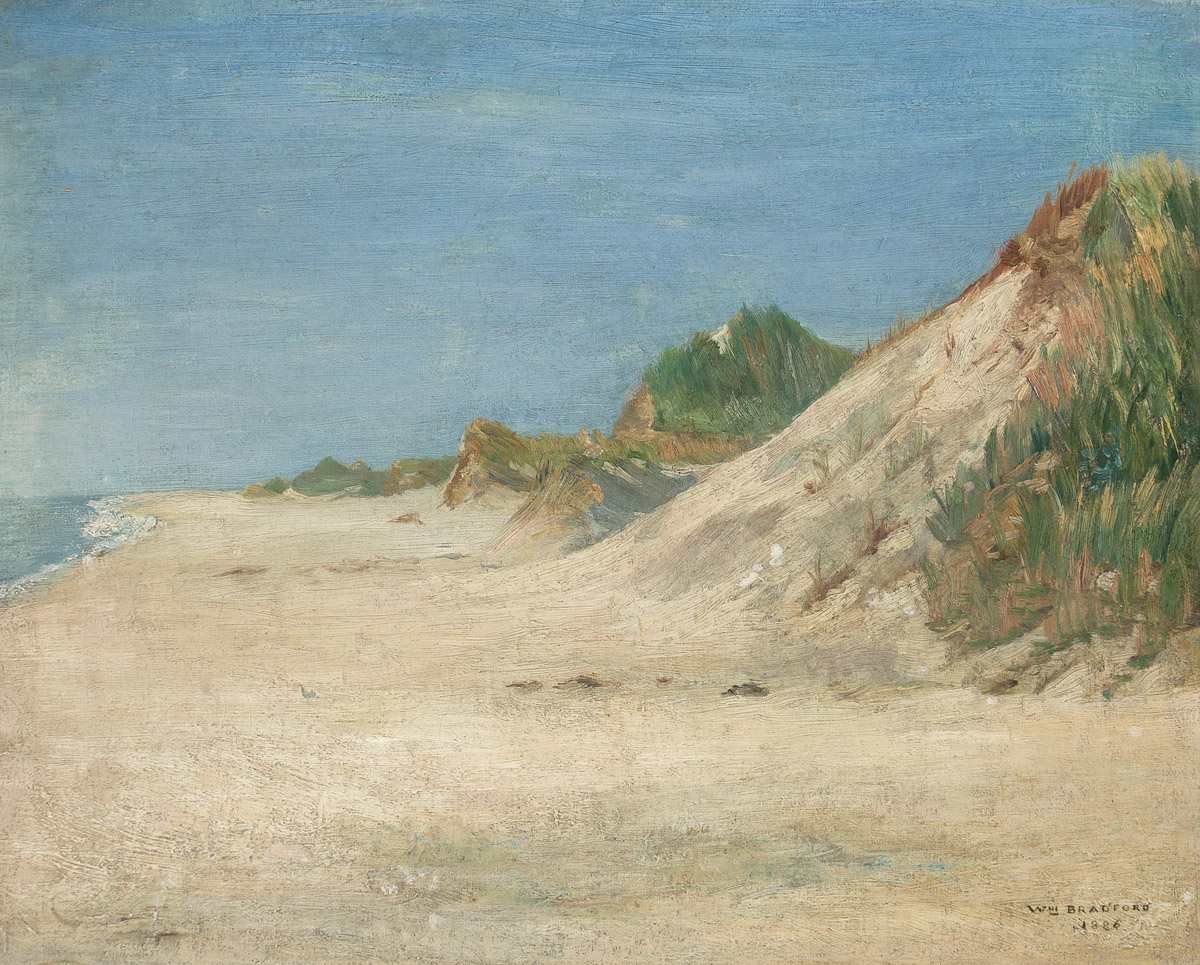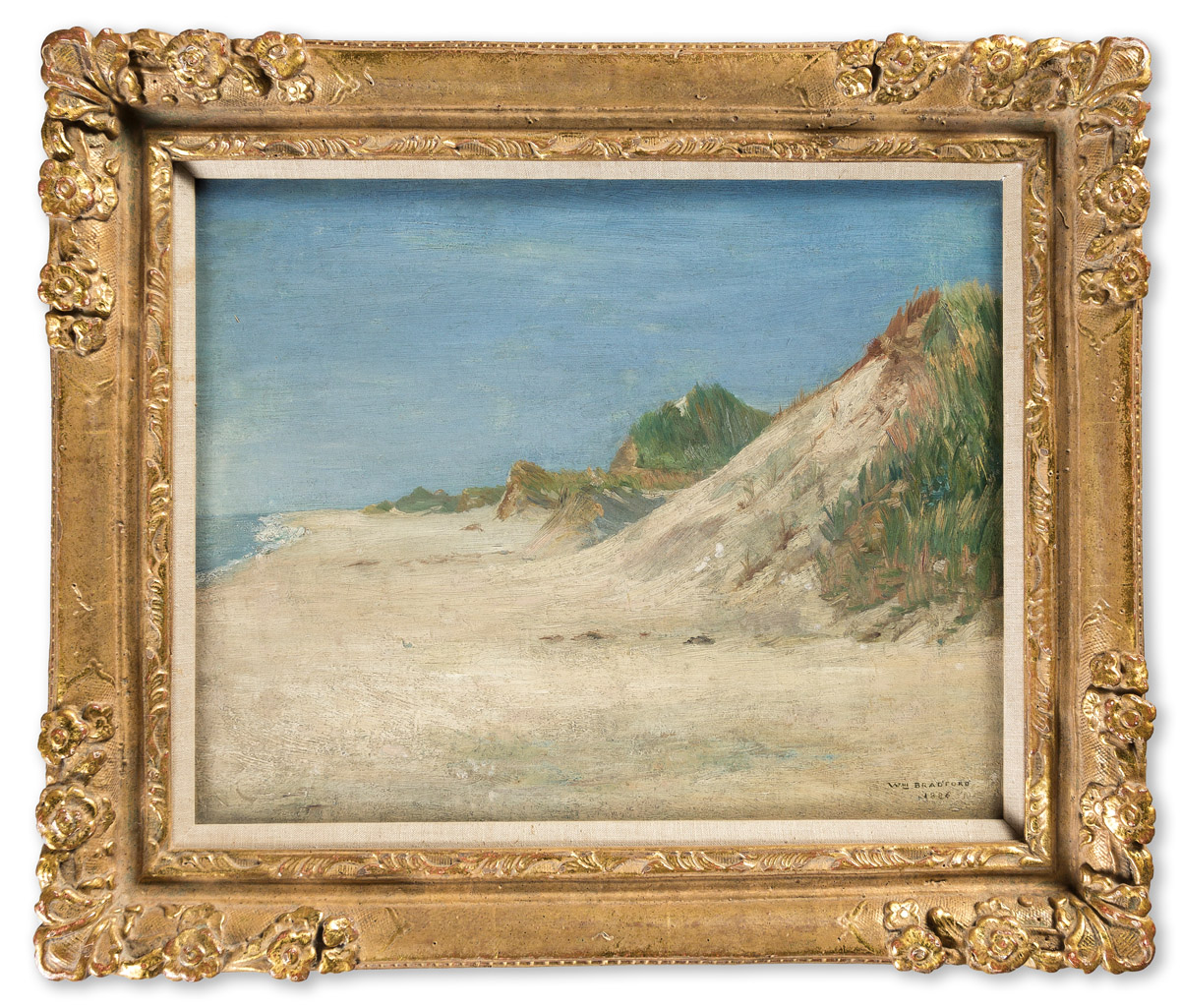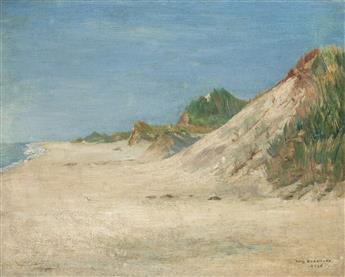Sale 2614 - Lot 28
Unsold
Estimate: $ 10,000 - $ 15,000
WILLIAM BRADFORD
Sand Dunes, Bradley Beach, New Jersey.
Oil on canvas, 1886. 408x506 mm; 16 1/4x20 inches. Signed and dated in oil, lower right recto.
Provenance: Mr. and Mrs. John Powell, Los Angeles; Brand Library, Glendale, California; private collection, Chicago.
Bradford (1823-1892) was an American romanticist painter, photographer and explorer, originally from Fairhaven, Massachusetts, near New Bedford. He was a notable marine painter and was, along with his contemporaries Frederic Edwin Church (1826-1900) and Albert Bierstadt (1830-1902), among the first American painters to portray the frozen regions of the Arctic. From 1861 to 1866 Bradford made excursions north to Labrador with Dr. Isaac Israel Hayes. With funds provided by LeGrand Lockwood, Bradford traveled to Greenland in 1869, his farthest northern excursion, reaching eventually as far as 75° north latitude aboard the steamship Panther, accompanied by photographers John L. Dunmore and George Critcherson. Thereafter, Bradford spent two years in London, promoting his explorations, and later in the 1870s established a studio in San Francisco and traveled extensively in the western United States where he painted Yosemite, Mariposa Valley and the mountains of the Sierra Nevada.
Despite his far-reaching travels, focus on marine paintings and association with the American west, he was like his friend and fellow New Bedford transplant Albert Bierstadt, consistently associated with the Hudson River School, adopting their techniques and becoming highly interested in the way light touches water and how it affects the appearance of water surfaces and the general atmospherics of a painting. In 1874, he was elected to join the National Academy of Design, New York.
Bradley Beach, the subject of the current work, is now a borough in Monmouth County, New Jersey, and became a seaside destination during the 1870s when several investors started its development. It was the first location in the United States to charge sea bathers for beach access when it began minting its own tin badges starting in 1929.
Sand Dunes, Bradley Beach, New Jersey.
Oil on canvas, 1886. 408x506 mm; 16 1/4x20 inches. Signed and dated in oil, lower right recto.
Provenance: Mr. and Mrs. John Powell, Los Angeles; Brand Library, Glendale, California; private collection, Chicago.
Bradford (1823-1892) was an American romanticist painter, photographer and explorer, originally from Fairhaven, Massachusetts, near New Bedford. He was a notable marine painter and was, along with his contemporaries Frederic Edwin Church (1826-1900) and Albert Bierstadt (1830-1902), among the first American painters to portray the frozen regions of the Arctic. From 1861 to 1866 Bradford made excursions north to Labrador with Dr. Isaac Israel Hayes. With funds provided by LeGrand Lockwood, Bradford traveled to Greenland in 1869, his farthest northern excursion, reaching eventually as far as 75° north latitude aboard the steamship Panther, accompanied by photographers John L. Dunmore and George Critcherson. Thereafter, Bradford spent two years in London, promoting his explorations, and later in the 1870s established a studio in San Francisco and traveled extensively in the western United States where he painted Yosemite, Mariposa Valley and the mountains of the Sierra Nevada.
Despite his far-reaching travels, focus on marine paintings and association with the American west, he was like his friend and fellow New Bedford transplant Albert Bierstadt, consistently associated with the Hudson River School, adopting their techniques and becoming highly interested in the way light touches water and how it affects the appearance of water surfaces and the general atmospherics of a painting. In 1874, he was elected to join the National Academy of Design, New York.
Bradley Beach, the subject of the current work, is now a borough in Monmouth County, New Jersey, and became a seaside destination during the 1870s when several investors started its development. It was the first location in the United States to charge sea bathers for beach access when it began minting its own tin badges starting in 1929.
Exhibition Hours
Exhibition Hours
Aliquam vulputate ornare congue. Vestibulum maximus, libero in placerat faucibus, risus nisl molestie massa, ut maximus metus lectus vel lorem.






